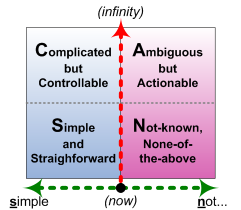Yup, I admit: I got it wrong. (Well, the kind of ‘wrong’ that happens often in early-stage development-work, anyway. ![]() )
)
In my initial version of the SCAN sensemaking-framework, I wasn’t happy with the ‘A’ keyword for the ‘not-certain but we do have time to make it sort-of work’ domain (upper-right quadrant). I’d started with Agile, but that’s more about a set of methods that we use in that domain. I’d floundered around with a whole bunch of different keywords, but settled for the awkward ‘Actionable but Awkward‘ because I couldn’t think of anything else.
Courtesy of a blog-post I was reading when a comment from the incomparable Cynthia Kurtz about the previous post came in, this is the all-too-obvious alternative: Ambiguous.
(Duh… I shoulda seen that one much earlier… oh well… [beats self with horse-whip, remembers eventually that all that does is hurt… ![]() dumps horse-whip, gets back to writing…])
dumps horse-whip, gets back to writing…])
More to the point, in another comment, Cynthia shows that it would work better if I switch the statement round:
I love ambiguous. Only I would say it as “ambiguous but actionable” matching your other three as what-it-is then what-you-can-do. And it is perfect that the N-spot does away with what-you-can-do because it’s not that simple there. I also like how you have “but” on the top and “and” on the bottom, which is meaningful.
I hadn’t noticed that distinction between ‘but’ versus ‘and’ – entirely accidental, to be honest – but again, she’s right. It’s only when we have time to argue that we can afford the luxury of ‘but’; when time is compressed to almost-nothing, all we have time for is the improviser’s ‘Yes, and…’.
Anyway, courtesy of those two exactly-to-the-point comments from Cynthia Kurtz, here’s the updated core-graphic:
More posts about how to use this in real-world practice will be coming up Real Soon Now, I promise!
Hope it’s useful, anyway?
